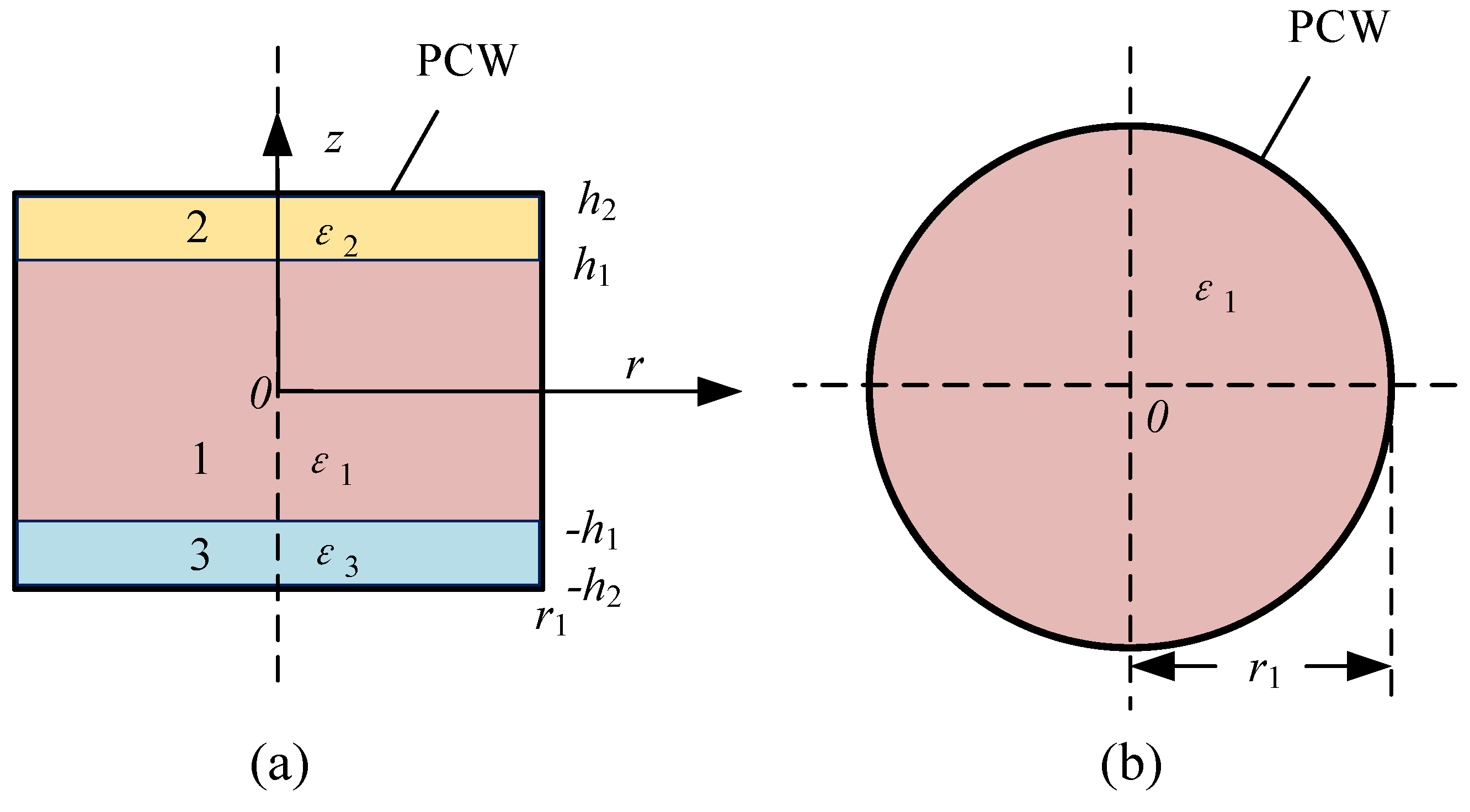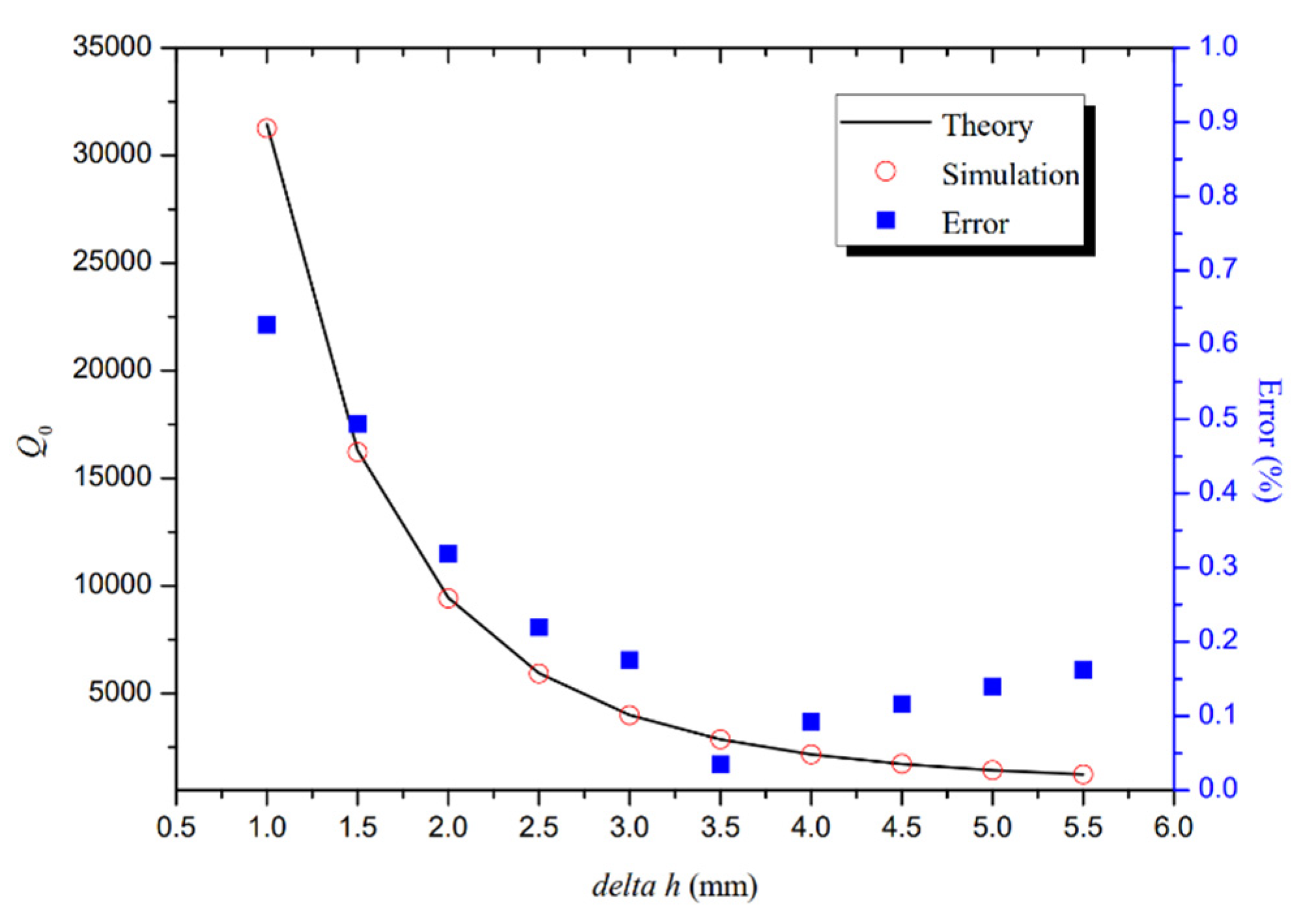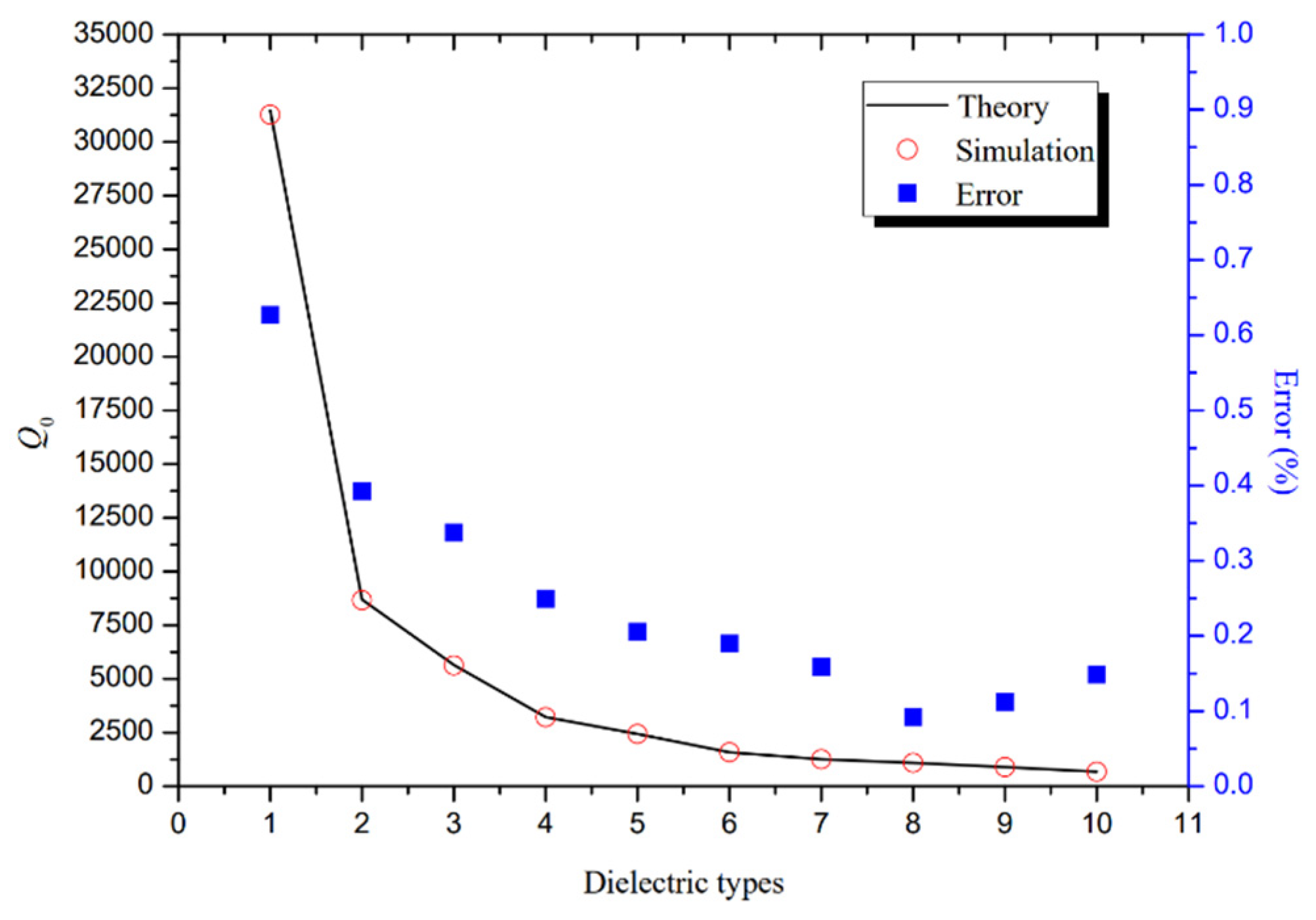Calculation and Analysis of Characteristic Parameters for Lossy Resonator
Abstract
:1. Introduction
2. Calculation and Analysis Model
- Developing electromagnetic field expressions and dividing regions. The electromagnetic field components of each zone in the entire model were determined by the Borgnis function, which was separated into numerous regular portions;
- Acquiring characteristic equations. By using the mode-matching method, some equations were created at the interface between various dielectrics;
- Numerical simulation. This process used the secant method to numerically solve for the resonant frequency and Q value, which can result in rapid convergence.
2.1. Establishment of Electromagnetic Field Components in Each Region
2.2. Boundary Conditions and Characteristic Equations
2.3. The Solution Method of Characteristic Equations
3. Numerical Calculation Results and Analysis of the Influence of Dielectric Structure on Resonance Characteristics
3.1. Analysis of the Influence of Dielectric Thickness on Resonance Characteristics
3.2. Analysis of the Influence of Dielectric Loss on Resonance Characteristics
4. Conclusions
Author Contributions
Funding
Conflicts of Interest
Appendix A
Appendix B
References
- Zhang, P.; Yang, B.; Yi, C.; Wang, H.; You, X. Measurement-Based 5G Millimeter-Wave Propagation Characterization in Vegetated Suburban Macrocell Environments. IEEE Trans. Antennas Propag. 2020, 68, 5556–5567. [Google Scholar] [CrossRef]
- Meng, M.; Wu, K.L. An Analytical Approach to Computer-Aided Diagnosis and Tuning of Lossy Microwave Coupled Resonator Filters. IEEE Trans. Microw. Theory Tech. 2009, 57, 3188–3195. [Google Scholar] [CrossRef]
- Zaki, K.A.; Chen, C. Loss mechanisms in dielectric-loaded resonators. IEEE Trans. MTT 1985, 33, 1448–1452. [Google Scholar] [CrossRef]
- Santos, T.; Valente, M.A.; Monteiro, J.; Sousa, J.; Costa, L.C. Electromagnetic and thermal history during microwave heating. Appl. Therm. Eng. 2011, 31, 3255–3261. [Google Scholar] [CrossRef] [Green Version]
- Chen, H.; Li, T.; Li, K.; Li, Q. Experimental and numerical modeling research of rubber material during microwave heating process. Heat Mass Transf. 2018, 54, 1289–1300. [Google Scholar] [CrossRef]
- Chen, C.; Pan, L.; Jiang, S.; Yin, S.; Li, X.; Zhang, J.; Feng, Y.; Yang, J. Electrical conductivity, dielectric and microwave absorption properties of graphene nanosheets/magnesia composites. J. Eur. Ceram. Soc. 2018, 38, 1639–1646. [Google Scholar] [CrossRef]
- Wei, Y.; Shi, Y.; Zhang, X.; Jiang, Z.; Zhang, Y.; Zhang, L.; Zhang, J.; Gong, C. Electrospinning of lightweight TiN fibers with superior microwave absorption. J. Mater. Sci. Mater. Electron. 2019, 30, 14519–14527. [Google Scholar] [CrossRef]
- Mo, R.; Yin, X.; Ye, F.; Liu, X.; Ma, X.; Li, Q.; Zhang, L.; Cheng, L. Electromagnetic wave absorption and mechanical properties of silicon carbide fibers reinforced silicon nitride matrix composites. J. Eur. Ceram. Soc. 2018, 39, 743–754. [Google Scholar] [CrossRef]
- Godone, A.; Micalizio, S.; Levi, F.; Calosso, C. Microwave cavities for vapor cell frequency standards. Rev. Sci. Instrum. 2011, 82, 074703. [Google Scholar] [CrossRef]
- Micalizio, S.; Levi, F.; Calosso, C.E.; Gozzelino, M.; Godone, A. A pulsed-Laser Rb atomic frequency standard for GNSS applications. GPS Solut. 2021, 25, 94. [Google Scholar] [CrossRef]
- Huang, Q. Analysis for Resonant Characteristic of Microwave Cavity Loaded with Complex Structure Dielectric in Rubidium Frequency Standard. Master Thesis, Lanzhou University, Lanzhou, China, 2009. [Google Scholar]
- Song, L. Design of Microwave-heated System and Research on Electromagnetic Field in Resonant Cavity. Master Thesis, China University of Petroleum, Shandong, China, 2007. [Google Scholar]
- Jin, S.; Li, Z.; Huang, F.; Gan, D.; Cheng, R.; Deng, G. Constrained shell finite element method for elastic buckling analysis of thin-walled members. Thin-Walled Struct. 2019, 145, 106409. [Google Scholar] [CrossRef]
- Hirayama, K.; Hayashi, Y. Finite element analysis for complex permittivity measurement of a dielectric plate and its application to inverse problem. Trans. IEICI (c) 2000, J83-C, 623–631. [Google Scholar] [CrossRef]
- Bofeng, W.; Yongqing, Z.; Zhaochuan, Z.; Weilong, W.; Honghong, G.; Yuan, L.; Yingqin, L.; Xiangyang, G. Microstructure and Microwave Attenuation Properties of Kanthal Coating Prepared by Selective Laser Melting. Rare Met. Mater. Eng. 2020, 49, 3143–3152. [Google Scholar]
- Jiao, C.; Luo, J. Propagation of electromagnetic wave in a lossy cylindrical waveguide. Acta Phys. Sin. 2006, 12, 6360–6367. [Google Scholar] [CrossRef]
- Tanaka, H.; Tsutsumi, A. Precise measurement of microwave permittivity based on the electromagnetic fields in a cavity resonator with finite conductivity walls. IEICE Trans. Electron. 2003, E86-C, 2387–2393. [Google Scholar]
- Tanaka, H.; Tsutsumi, A. Analysis of Resonant Characteristics of Cavity Resonator with a Layered Conductor on its Metal Walls. IEICE Trans. Electron. 2003, E86-C, 2379–2386. [Google Scholar]
- Kobayashi, Y. Standard measurement methods of dielectric and superconducting materials in microwave and millimeter waves. Tech. Rep. IEICE 1999, MW99-108, 1–6. [Google Scholar]
- Krupka, J.; Gregory, A.P.; Rochard, O.C.; Clarke, R.N.; Riddle, B.; Baker-Jarvis, J. Uncertainty of Complex Permittivity Measurements by Split-Post Dielectric Resonator Technique. Eur. Ceram. Soc. 2001, 21, 2673–2676. [Google Scholar] [CrossRef]
- Zhang, K.; Li, D. Electromagnetic Theory for Microwaves and Optoelectronics; Publishing House of Electronics Industry: Beijing, China, 2001; pp. 182–206. [Google Scholar]
- Harrington, R.F. Time-Harmonic Electromagnetic Fields; McGraw-Hill Book Company, Inc.: New York, NY, USA, 1961; pp. 198–263. [Google Scholar]
- Zaki, K.A.; Atia, A.E. Modes in Dielectric-Loaded Waveguides and Resonators. IEEE Trans. Microw. Theory Tech. 1983, 31, 1039–1045. [Google Scholar] [CrossRef]
- Monsalve, M.; Raydan, M. Newton’s method and secant methods: A longstanding relationship from vectors to matrices. Port. Math. 2011, 68, 431–475. [Google Scholar] [CrossRef]
- Beavers, A.N.; Denman, E.D. A computational method for eigenvalues and eigenvectors of a matrix with real eigenvalues. Numer. Math. 1974, 21, 389–396. [Google Scholar] [CrossRef]
- Joshi, M.K.; Bhattacharjee, R. Design of a rectangular waveguide to cylindrical cavity mode launcher for TE011 mode with maximum quality-factor. Int. J. RF Microw. Comput.-Aided Eng. 2019, 29, e21825. [Google Scholar] [CrossRef]
- Zeng, K.; Hu, Y.; Deng, G.; Sun, X.; Su, W.; Lu, Y.; Duan, J.A. Investigation on Eigenfrequency of a Cylindrical Shell Resonator under Resonator-Top Trimming Methods. Sensors 2017, 17, 2011. [Google Scholar] [CrossRef] [PubMed] [Green Version]
- Korenev, B.G. Bessel Functions and Their Applications; Taylor and Francis: Abingdon, UK, 2004; pp. 105–114. [Google Scholar]
- Xu, L.; Yu, W.; Chen, J.X. Unbalanced-/Balanced-to-Unbalanced Diplexer Based on Dual-Mode Dielectric Resonator. IEEE Access 2021, 9, 53326–53332. [Google Scholar] [CrossRef]
- Jayant, P. Proof of a Bessel Function Integral. Resonance 2022, 27, 1411–1428. [Google Scholar]
- Pertl, F.A.; Smith, J.E. Electromagnetic design of a novel microwave internal combustion engine ignition source, the quarter wave coaxial cavity igniter. Proc. Inst. Mech. Eng. Part D J. Automob. Eng. 2009, 233, 1405–1417. [Google Scholar] [CrossRef]







| delta h/mm | frc/GHz | frs/GHz | Error |
|---|---|---|---|
| 1.0 | 3.6661 | 3.6651 | 0.027% |
| 1.5 | 3.5672 | 3.5661 | 0.031% |
| 2.0 | 3.4600 | 3.4588 | 0.035% |
| 2.5 | 3.3443 | 3.3429 | 0.042% |
| 3.0 | 3.2206 | 3.2189 | 0.053% |
| 3.5 | 3.0905 | 3.0889 | 0.052% |
| 4.0 | 2.9562 | 2.9544 | 0.061% |
| 4.5 | 2.8201 | 2.8186 | 0.053% |
| 5.0 | 2.6846 | 2.6825 | 0.078% |
| 5.5 | 2.5514 | 2.5496 | 0.071% |
| delta h/mm | Q0c | Q0s | Error |
|---|---|---|---|
| 1.0 | 31,460 | 31,264 | 0.627% |
| 1.5 | 16,295 | 16,215 | 0.493% |
| 2.0 | 9448 | 9418 | 0.319% |
| 2.5 | 5938 | 5925 | 0.219% |
| 3.0 | 3997 | 3990 | 0.175% |
| 3.5 | 2862 | 2861 | 0.035% |
| 4.0 | 2169 | 2167 | 0.092% |
| 4.5 | 1724 | 1726 | 0.116% |
| 5.0 | 1432 | 1434 | 0.139% |
| 5.5 | 1233 | 1235 | 0.162% |
| εr2 | tan δ | frc/GHz | frs/GHz | Error |
|---|---|---|---|---|
| 11.4 | 0.00270 | 3.6661 | 3.6651 | 0.027% |
| 8.2 | 0.00780 | 3.6741 | 3.6731 | 0.027% |
| 7.5 | 0.01120 | 3.6766 | 3.6756 | 0.027% |
| 6.1 | 0.01660 | 3.6831 | 3.6822 | 0.024% |
| 5.3 | 0.01940 | 3.6882 | 3.6873 | 0.024% |
| 4.1 | 0.02375 | 3.6995 | 3.6986 | 0.024% |
| 3.5 | 0.02585 | 3.7079 | 3.7070 | 0.024% |
| 3.2 | 0.02755 | 3.7132 | 3.7123 | 0.024% |
| 2.8 | 0.02965 | 3.7220 | 3.7211 | 0.024% |
| 2.5 | 0.03545 | 3.7303 | 3.7295 | 0.021% |
| εr2 | tan δ | Q0c | Q0s | Error |
|---|---|---|---|---|
| 11.4 | 0.00270 | 31,460 | 31,264 | 0.627% |
| 8.2 | 0.00780 | 8698 | 8664 | 0.392% |
| 7.5 | 0.01120 | 5652 | 5633 | 0.337% |
| 6.1 | 0.01660 | 3218 | 3210 | 0.249% |
| 5.3 | 0.01940 | 2439 | 2434 | 0.205% |
| 4.1 | 0.02375 | 1585 | 1582 | 0.190% |
| 3.5 | 0.02585 | 1261 | 1259 | 0.159% |
| 3.2 | 0.02755 | 1089 | 1088 | 0.092% |
| 2.8 | 0.02965 | 895 | 894 | 0.112% |
| 2.5 | 0.03545 | 675 | 674 | 0.148% |
Disclaimer/Publisher’s Note: The statements, opinions and data contained in all publications are solely those of the individual author(s) and contributor(s) and not of MDPI and/or the editor(s). MDPI and/or the editor(s) disclaim responsibility for any injury to people or property resulting from any ideas, methods, instructions or products referred to in the content. |
© 2022 by the authors. Licensee MDPI, Basel, Switzerland. This article is an open access article distributed under the terms and conditions of the Creative Commons Attribution (CC BY) license (https://creativecommons.org/licenses/by/4.0/).
Share and Cite
Cui, J.; Yu, Y.; Lu, Y. Calculation and Analysis of Characteristic Parameters for Lossy Resonator. Electronics 2023, 12, 7. https://doi.org/10.3390/electronics12010007
Cui J, Yu Y, Lu Y. Calculation and Analysis of Characteristic Parameters for Lossy Resonator. Electronics. 2023; 12(1):7. https://doi.org/10.3390/electronics12010007
Chicago/Turabian StyleCui, Jian, Yu Yu, and Yuanyao Lu. 2023. "Calculation and Analysis of Characteristic Parameters for Lossy Resonator" Electronics 12, no. 1: 7. https://doi.org/10.3390/electronics12010007
APA StyleCui, J., Yu, Y., & Lu, Y. (2023). Calculation and Analysis of Characteristic Parameters for Lossy Resonator. Electronics, 12(1), 7. https://doi.org/10.3390/electronics12010007







